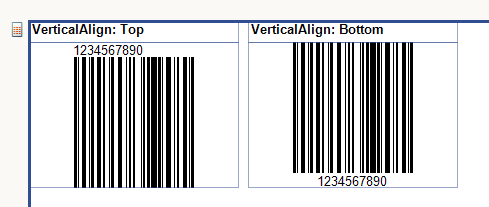Specifications of the One-dimensional Barcode Items
One-dimensional (1D) barcodes are made up of lines and spaces of various widths that create specific patterns.
The following table describes the specific characteristics of the barcodes per type.
Common Settings
One-dimensional Barcodes support the ShowText common setting. When ShowText is set to true, the Barcode shows the text together with the bars.
When the text is displayed, you can also align it horizontally by using the TextAlign property of the Style object.

You can also use the VerticalAlign property of the Style object to align the Barcode vertically.

Code128 Specifics
The one-dimensional Code128 barcode is subject to the following specifics:
Subsets
Code128A, Code128B, and Code128C represent the A, B and C subsets of the Code128 symbology. Code128 uses an intelligent algorithm that picks automatically the appropriate subset according to the input value, and may switch between these subsets in the middle of a barcode to produce a shorter generated sequence.
For example, if you have the input string ABCD1234, the ABCD part of the string will be encoded by using the A subset, while the 1234 part will be encoded with the C subset, because Code128C uses a double-density code for numerical values, thus producing a shorter barcode as a result. To disable this behavior, explicitly specify a subset (Code128A, Code128B, or Code128C) to the Symbology property of the Barcode report item.
Control Characters
Code128 can represent both ASCII characters and non-ASCII control characters. Normally, the Barcode report item automatically inserts the appropriate control characters to conform to the Code128 specification.
However, certain applications may require you to manually insert certain control characters, such as the FNC1-FNC4 functional characters. For this purpose, the Barcode report item assigns special Unicode values to these control characters outside the normal 0-127 ASCII code range.
The following table lists all Code128 control characters and their corresponding Unicode values:
| Control Character | Hexadecimal | Decimal |
|---|---|---|
| Code A | F4 | 244 |
| Code B | F5 | 245 |
| Code C | F6 | 246 |
| FNC1 | F7 | 247 |
| FNC2 | F8 | 248 |
| FNC3 | F9 | 249 |
| FNC4 | FA | 250 |
| Shift | FB | 251 |
| Start A | FC | 252 |
| Start B | FD | 253 |
| Start C | FE | 254 |
| Stop | FF | 255 |
For example, the following code inserts the FNC4 control character in the middle of a Barcode:
this.Barcode1.Value = "ABCD" + "\u00FA" + "1234";
Me.Barcode1.Value = "ABCD" & ChrW(&HFA) & "1234"
GS1-128 Specifics
GS1-128 is a special case of Code128. The only difference between GS1-128 and Code 128 is that GS1-128 inserts the FNC1 control character at the beginning of the barcode to conform to the GS1-128 specification.
If you have a multi-part GS1-128 barcode which requires the FNC1 control character as a delimiter between the different parts, you have to insert it manually.
this.Barcode1.Value = "1234" + "\u00F7" + "5678";
Me.Barcode1.Value = "1234" & ChrW(&HF7) & "5678"